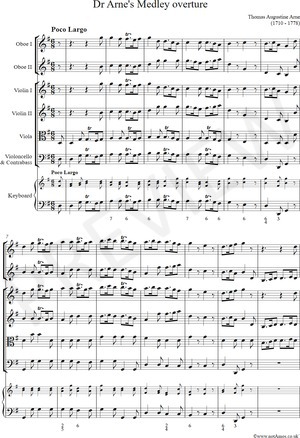 notAmos Performing Editions 1 Lansdown Place East, Bath BA1 5ET, UK +44 (0) 1225 316145 Performing editions of pre‑classical music with full preview/playback and instant download |
Thomas Arne
(1710 - 1778)

Medley Overture
(2Ob.2Vn.Va.Vc.Kbd)
Full score (PDF), €4.00 for a single copy Buy this item(1710 - 1778)

Medley Overture
(2Ob.2Vn.Va.Vc.Kbd)
Oboe I part (PDF), €1.00 for unlimited copies Buy this item
Oboe II part (PDF), €1.00 for unlimited copies Buy this item
Violin I part (PDF), €1.00 for unlimited copies Buy this item
Violin II part (PDF), €1.00 for unlimited copies Buy this item
Viola part (PDF), €1.00 for unlimited copies Buy this item
Violoncello & Contrabass part (PDF), €1.00 for unlimited copies Buy this item
Keyboard part (PDF), €1.00 for unlimited copies Buy this item
Printable cover page (PDF), €0.00 for unlimited copies Download this item
Score, part(s) and cover page (PDF), €10.50 for bundled copies Buy this item
If you have any problem obtaining a PDF, please see our help page. If that does not resolve the issue, please click here.
For licensing/copyright information please click here
| Enquire about this score |
| About Thomas Arne |
| Full Catalogue |
| About us | Help, privacy, cookies |
| About Thomas Arne |
| Full Catalogue |
| About us | Help, privacy, cookies |
Although not published until 1763, Arne's Medley Overture appears to have been written some 30 years earlier, possibly for use with the pantomime "Harlequin Restor'd", with subsequent rehearsals at similar productions. The joke is the same as that used in the Gay/Pepusch prototype of the "Beggar's Opera": in this case Arne opens with "The Black Joke" (the tune being a vehicle for the bawdiest song written since the death of Thomas D'Urfey: see the notAmos edition of that song) treated in high style, and then proceeds to quote both "low" tunes and "high" (e.g. Handel organ concerto op.4 no.2). Some of these quotes are no more than brief allusions, e.g. the Cotillon (also used in the Beggar's Opera as "Youth's the season made for joys", bars 40 and 41).
This overture shares features with others published as a set of six (Charke, Lampe, Howard, Prelleur (2)): all are described in the frontispiece as being of seven parts; in practice oboe parts diverge from those of the violins only in exceptional circumstances, and the violins frequently merge. Thus any harmony in more than two parts is perfunctory. One gets an impression of scores catering for an ad hoc and fluid orchestra, for which volume was more important than aesthetic subtlety. That impression mirrors the accounts by Charlotte Charke (Charke's wife, and Arne's niece by marriage) in her entertaining if unreliable memoirs of a "strolling player".
This overture shares features with others published as a set of six (Charke, Lampe, Howard, Prelleur (2)): all are described in the frontispiece as being of seven parts; in practice oboe parts diverge from those of the violins only in exceptional circumstances, and the violins frequently merge. Thus any harmony in more than two parts is perfunctory. One gets an impression of scores catering for an ad hoc and fluid orchestra, for which volume was more important than aesthetic subtlety. That impression mirrors the accounts by Charlotte Charke (Charke's wife, and Arne's niece by marriage) in her entertaining if unreliable memoirs of a "strolling player".
